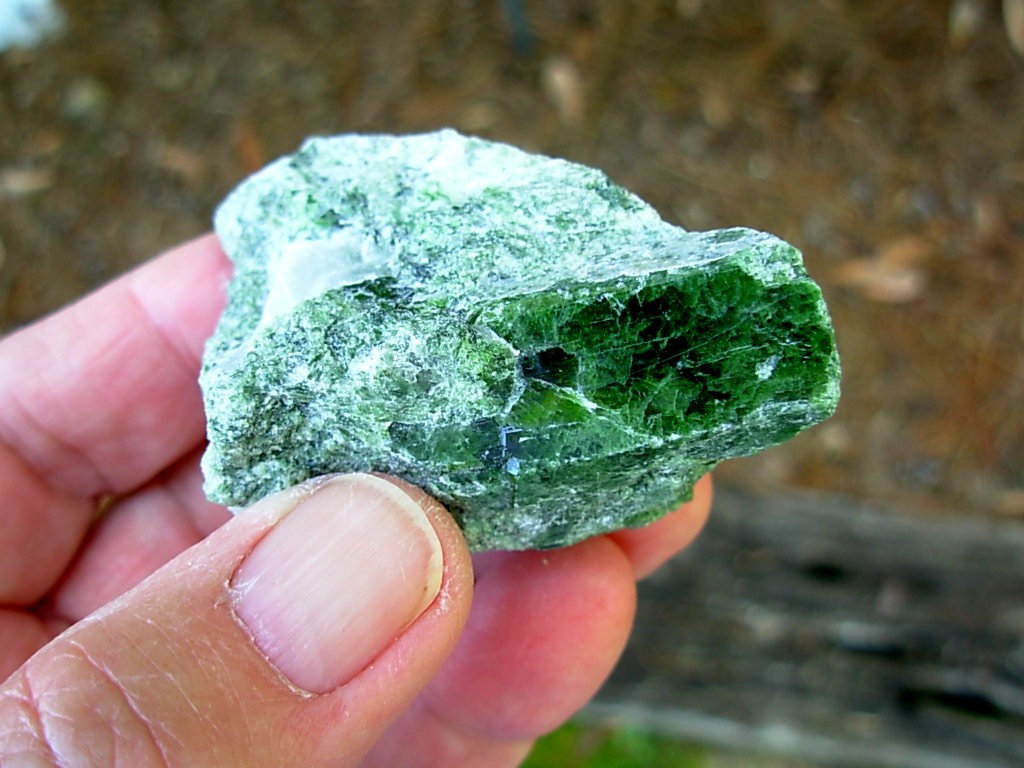Diopside
Diopside is a silicate mineral that is usually light green to dark green, but it is occasionally found in blue, brown, colorless, white or grey. It may form crystals that are short prismatic crystals, or it may form granular, columnar or massive crystals. Diopside is an important rock forming mineral in several metamorphic and igneous rocks, also found in meteorites. Diopside is an important part of the pyroxene group. Pyroxenes are the most significant and abundant group of rock-forming ferromagnesian silicates. They are found in almost every variety of igneous rock.
The name pyroxene is derived from the Greek words pyro, meaning “fire,” and xenos, meaning “stranger,” and was given by Haüy to the greenish crystals found in many lavas which he considered to have been accidentally included there. Diopside has two distinct prismatic cleavages at 87 and 93° typical of the pyroxene series. Diopside derives its name from the Greek words dis meaning "twice", and òpsè, meaning "face". The name is believed to be in reference to the two prismatic cleavages. Diopside was first described around the year 1800.
Diopside is found in ultramafic igneous rocks such as kimberlite and peridotite, and diopside-rich augite is common in mafic rocks, such as olivine basalt and andesite. Ultramafic rocks are igneous rocks with a very low silica content, with high magnesium and iron content, low potassium, and are composed of usually greater than 90% mafic minerals (dark colored, high magnesium and iron content). The Earth's mantle is composed of ultramafic rocks. Diopside is also found in a variety of metamorphic rocks, such as in skarns formed from high silica content dolomites. It is an important mineral in the Earth's mantle and is common in peridotite xenoliths erupted in kimberlite and alkali basalt.
Diopside has several varieties used for gemstones, including a chromium-rich gem variety called chrome Diopside. Recently Russian Chrome Dioxide has become one of the most in demand varieties of gem grade Diopside. Violan is a rare blue variety of Diopside found in Italy. There is also a green variety referred to as “Cats Eye Diopside” that contains minute inclusions that produce a visible luminescence within the crystal.
Star Diopside is black, with inclusions of rutile needles that produce a four ray star, Ordinary Diopside is typically white or green and can have a nice glassy luster. While the color of chrome Diopside is much brighter, many specimens of ordinary Diopside are also cut for gemstones. Mineral specimens of Diopside with distinct crystal formations make excellent displays for your rock and mineral collections.
Item# 1DIOP05149601
Diopside from Brazil

Diopside from Brazil
A very nice specimen of Diopside from Minas Gerais Brazil with distinct crystal formations. A great specimen for your collection!
This specimen weighs 3.7 oz or 0.23 lbs (105g) and measures 2.8 x 1.4 x 1 inches (71 x 37 x 25mm)
Item# 2DIOP05148601
Diopside from Brazil

Diopside from Brazil
A very nice specimen of Diopside from Minas Gerais Brazil with a distinct crystal surface formation. A great specimen for your collection!
This specimen weighs 3.1 oz or 0.19 lbs (89g) and measures 2.6 x 1.4 x 1 inches (66 x 36 x 27mm)













